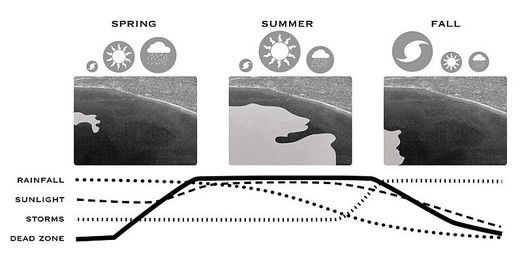What causes Hypoxia?
Hypoxia can be caused due to a lot of reasons.
1. Eutrophication
2. Climate
3. Dead remains of the organisms.
Eutrophication

Eutrophication in action.
Aquatic and marine dead zones can be caused by an increase in chemical nutrients (particularly nitrogen and phosphorus) in the water, known as eutrophication. These chemicals are the fundamental building blocks of single-celled, plant-like organisms that live in the water column, and whose growth is limited in part by the availability of these materials. Eutrophication can lead to rapid increases in the density of certain types of these phytoplankton, a phenomenon known as an algal bloom. Although these algae produce oxygen in the daytime via photosynthesis, during the night hours they continue to undergo cellular respiration and can therefore deplete the water column of available oxygen. In addition, when algal blooms die off, oxygen is used up further during bacterial decomposition of the dead algal cells. Both of these processes can result in a significant depletion of dissolved oxygen in the water, creating hypoxic conditions.
Climate.

Climate has a significant impact on the growth and decline of ecological dead zones. During Spring months, as rainfall increases, more nutrient rich water flows down the mouth of the Mississippi River. At the same time, as sunlight increases during the Spring, algal growth in the dead zones increases dramatically. In Fall months, tropical storms begin to enter the Gulf of Mexico and break up the dead zones and the cycle repeats again in the spring.
Dead remains of the organisms.
Remains of organisms found within sediment layers near the mouth of the Mississippi River indicate four hypoxic events before the advent of artificial fertilizer. In these sediment layers, anoxia-tolerant species are the most prevalent remains found. The periods indicated by the sediment record correspond to historic records of high river flow recorded by instruments at Vicksburg, Mississippi.
Go to: Effects
